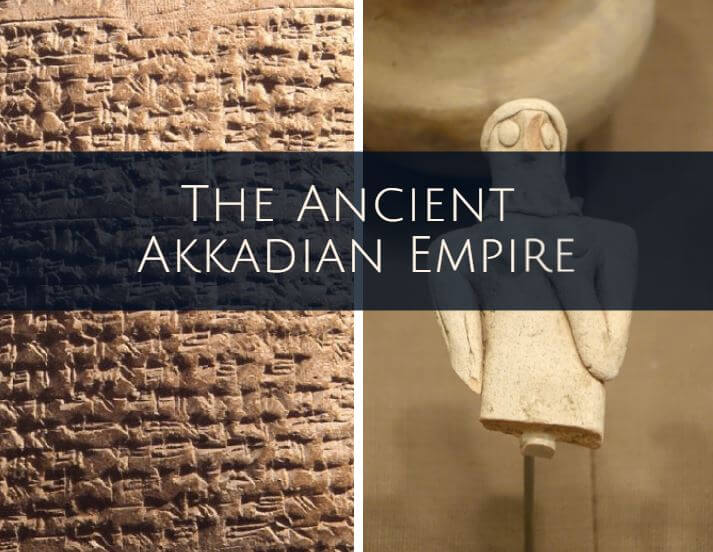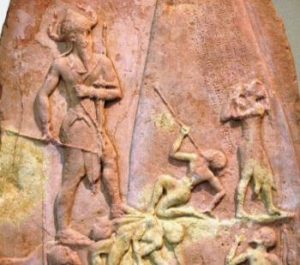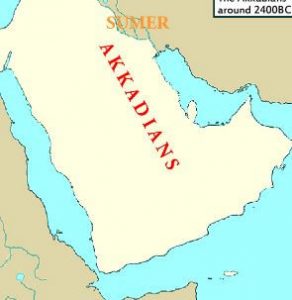The Akkadians were Semitic nomads, originating from the Arabian Peninsula, who began to migrate towards the Fertile Crescent at the time of the development of the first Mesopotamian city-states.
The Akkadians were one of the most important peoples in Mesopotamia, present in the north of the region, an area that included the city of Kish. In around 2340 BC, Sargon founded the city of Akkad, or Agade, near to Kish and likely in the north of Mesopotamia. However it is speculated that it could have been around the confluence of the Tigris and Diyala rivers, in the outskirts of modern day Baghdad.
The Akkadians (2340 – 2190 BC)
Contents

Kish was a city in northern Lower Mesopotamia (which would later become Akkad’s land). It was likely founded at around the beginning of the third millennium, although there was an older human presence. It comprised the settlements of Ingharra and Uhaimir, along with others of less importance. It was located some 15 kilometers east of Babylon.
With this, Sargon became the first monarch in history to unite the entire Mesopotamian basin under the same ruler. Despite this unity likely being more theoretical than practical, the figure of Sargon was a constant role model for Mesopotamian monarchs.
Sargon embarked on a conquest of the Sumerian cities to the south. Lugal-zage-si of Umma’s earlier conquests laid the way for the Akkadian conqueror, who found that the independence of the many Sumerian cities had already been vanquished. The first in Sargon’s sights was Uruk, a city renowned for its great walls.
Sargon’s dynasty was the first in history to rule over culturally diverse peoples, meaning that it could be considered the first empire in history. His conquests left an indelible imprint on future generations, whose traditions deemed him to be the best monarch in history, the archetype of a long-standing king and the model of an effective government. Legends of his divine lineage were created and the stories of his conquests spread much further than the borders of his lands.
The First Mesopotamian Empire: The Akkadian Empire
- Founder: Sargon I
- Empire’s Height: Naram-Sin (Sargon I’s grandson)
Sargon I came to rule a vast part of Mesopotamia that included all of Sumer, which was known as the Akkadian Empire.
Political Organization

The Akkadians created the first united empire in Ancient Mesopotamia. It was a hereditary monarchy, meaning that the country was ruled by a King who was succeeded by his sons upon his death.
List of Rulers:
- Sargon I
- Rimush (son of Sargon I)
- Manishtushu (son of Sargon I)
- Naram-Sin (grandson of Sargon I)
- Shar-Kali-Sharri (son of Naram-Sin and great-grandson of Sargon I)
Sargon held important positions in the city of Kish. Culturally, Sargon was Semitic as it’s known that he spoke Akkadian. Sargon I’s origins began with his revolt against his lord in Kish and his decision to establish a new center of operations for his government.
Legends About the Origin of Sargon I (Sargon of Akkad)
While Lugal-zage-si reigned in Uruk, the chief cup-bearer of Kish usurped the throne, adopting the name Sargon, which can be translated as “legitimate King”.
According to this legend, Sargon was the son of one of the king of Kish’s palace gardeners, who ascended to the role of cup-bearer. At one point the gods decided that the reign of Ur-Zababa, the king up until then, had to end, passing royalty unto Sargon.
Another legend tells of Sargon being the son of a priestess, who had given birth in secret and left the newborn in a wicker basket floating in the river. The current carried Sargon until he was picked up by a drawer of water named Akki, who taught him the gardening profession. His ascendency to the throne was due to the goddess Ishtar having taken care of him while he was a gardener.
Economic Activities
Agriculture was the basic economic activity in ancient Mesopotamia due to the region’s excellent natural conditions and the manipulation of its rivers through irrigative works.
The Akkadian Empire’s expansion over various areas of Mesopotamia allowed it to obtain raw materials that were unavailable in Akkad. The subjugated populations contributed to the empire through tributes, which could be made through products as diverse as wood, dried fish, cereals, metals, salt and a wide range of handicrafts.

Akkadian Culture
Akkadian civilization used the cuneiform script, which they had adapted to their own language. Evidence has been found that the Akkadians also used Sumerian writing, but that Akkadian writing also began to be used following Sargon’s laws, especially among citizens who had been offered administrative posts by Sargon.
In regards to Akkadian architecture, it is worth noting that no architectural vestiges that would allow us to know exactly what architecture was like in this period remain. There are remains of works and palaces restored by the Akkadians, but the ruins of cities like Akkad and Sippar lie buried in unknown locations.
Akkadian Religion
The Akkadians practiced a polytheistic religion that had a lot in common with other Mesopotamian civilizations’ religions, like the Sumerians’. As such, it was a place with political and social organizations where religion was very important, with a powerful priesthood and where the ruler was considered to be the representative of the gods on Earth. The gods in Akkadian mythology were, in general, related to different natural phenomena and explanations of the ways of life in Akkadian society. The gods that make up Akkadian mythology are many, but the following can be considered the most important:
An or Anu: An was the sky god and was also considered to be the supreme ruler of all gods, with different phenomena relating to the heavens, like the stars and the constellations, also under his control. As in other mythologies, such as Greek mythology, where the sky god Uranus was described in the same way, in Sumerian mythology An was represented as a celestial dome that covered the Earth. The Akkadians inherited this representation of the god of the heavens from the Sumerians who, as the supreme god, also had the fates of other heavenly and divine beings under his command. Therefore, among his most important responsibilities, he was also tasked with judging human and divine crimes and any subsequent punishments.
Enlil or Bea: The god Enlil is of outstanding importance not only in Akkadian cosmology, but also in other related cultures, like those of the Sumerians, Assyrians, Babylonians and Hittites. Enlil was associated with the winds, storms and breathing. Enlil was also the father of several natural deities, such as the moon god and the wheat goddess. Due to Enlil’s close relationship with agriculture, he was one of the most prominent gods in the Akkadian pantheon and was considered responsible for storms and, consequently, rain.
Sin or Nanna: Sin was the moon god in the Akkadian pantheon, who was known as Nanna in the Sumerian pantheon. He was the main god of the city of Ur, so during this city-state’s period of supremacy, he reached heights that could rival the previously mentioned god An. Sin also had the important task of being the god of wisdom and related arts, due to the relationship of the moon with knowledge of astronomy and astrological divinations, which were extremely important aspects of Mesopotamian culture.
Utu: Utu was the Akkadian Sun god. The concept of the sun was of great importance in an agrarian-based society such as the Mesopotamians’, although the god Utu is exceeded in importance by other gods, such as the aforementioned god An. He was considered to be the god of justice and truth, since the sun sees and knows all.

Ishtar: The goddess Ishtar is one of the most well-known Mesopotamian goddesses today due to the famous remains of monuments dedicated to her kept in the Pergamon Museum in Berlin. Ishtar was the goddess of fertility, love, sex and passionate and fierce war. There are many myths relating to this popular goddess and her many lovers, and her cult has even been linked with rituals of sacred prostitution, although this has not yet been proven absolutely. As in all ancient civilizations, fertility was a fundamental part of life, economics and social organization, so Ishtar was considered a very popular goddess. Ishtar is also considered to be a deity parallel to other goddesses from other mythologies of the ancient world, like the Semitic goddess Astarte or the Greek Aphrodite.
Other important gods in the Akkadian pantheon were Enki or Ea, the creator of man, and the god Shamash, who was also linked to sun worship.
Decline and Fall of the Akkadian Empire
Gutian and Lullubian invasions, along with internal conflicts, precipitated the fall of the Akkadian Empire, Mesopotamia’s first empire (2190 – 2150 BC)
The Guti were a people from the east of the Tigris, who inhabited the Zagros Mountains at the end of the third millennium BC. They were possibly the ancestors of the Kurds, who took part in the struggles to dominate Akkad from 2000 BC, a kingdom that they came to occupy part of, first only briefly (2180 BC-2175 BC), and then later for a longer time (2159 BC-2116 BC).
The Akkadian Empire collapsed within 100 years, almost as rapidly as it had developed, thus bringing about a dark era. At the end of the reign of Naram-Sin’s son, Shar-Kali-Sharri, the empire evidently collapsed after the invasion of barbarians from the Zagros Mountains known as the Guti. It has recently been suggested that the Dark Age at the end of the Akkadian period (and the First Intermediate Period of Ancient Egypt) was linked to aridity, which increased rapidly and as there were no rains in the region of the Ancient Near East, it caused a global 100 year long drought. The fall of the Akkadian Empire established by Sargon I seems to have been as sudden as its rise, and little is known about the Guti in the period between the fall of Akkad (2083 BC) and the Sumerian Revival (2050 BC).
Akkadian Culture’s Contributions
The Akkadian Empire adopted Sumerian culture. However, they implemented certain administrative reforms; they established a rigorous territorial organization in which they had a central territory administered by the king, and several territorial subdivisions administered by one or several governors according to the area’s importance and size. They created a standing army. The King was deified in life.
The Akkadian language is one of the oldest Semitic languages, and the first documentary evidence of it, written in cuneiform characters, dates back to approximately 2400 BC. It was the language used in cultural spheres and diplomatic relations. The Assyrian and Babylonian dialects were derived from Akkadian, which were used in the territory until the Aramaic replaced them in the fourth century BC.
The Sumerian custom of raising large stelae, commemorative monuments, in special places in the cities continued during the Akkadian Empire. The power of empire was demonstrated and its military successes were publicized through these works. A mountainous landscape with trees can be seen in Naram-Sim’s stela, depicting a scene in which the figure of the king Naram-Sim dominates, being of a greater size than his subjects and enemies, and is crowned with a helmet with two horns from the gods. The victorious king crushes the corpses of his enemies with his foot, while he kills two others and others fall down. The Akkadian soldiers on a lower level raise their heads as a sign of admiration and respect for their king.
